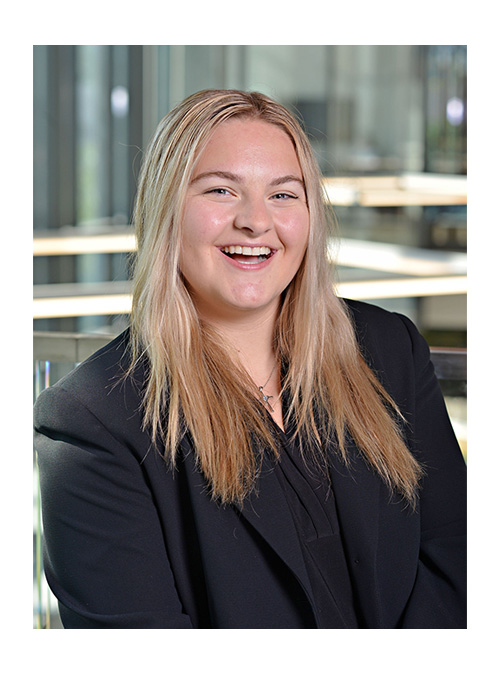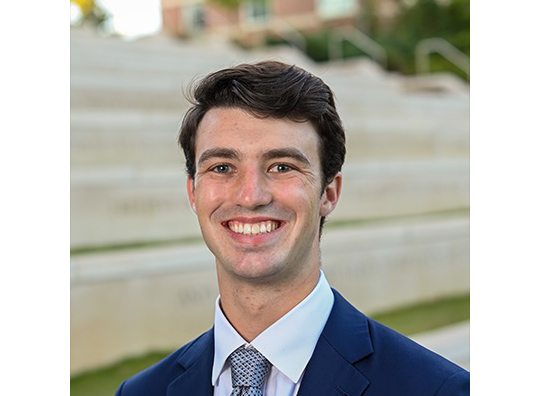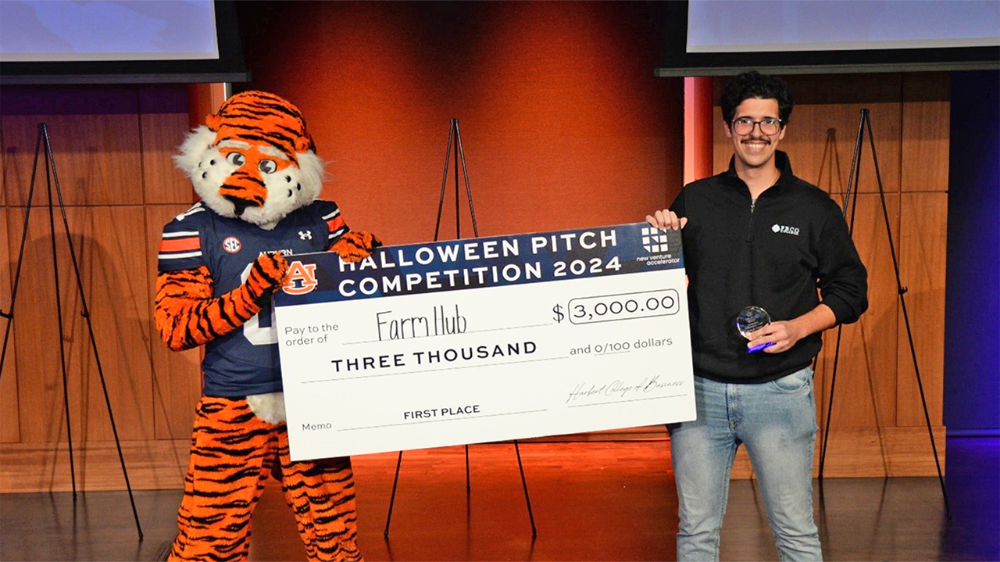Food Bank reps listen to student ideas for streamlining workflow
 Dressed in coats and ties, eyes alert and faces brimming with confidence, the small
group of 10 or so students in Erik Sjolseth’s Supply Chain Consulting class were split into two teams, each ready to give a semester-ending
presentation to business clients sitting in the room.
Dressed in coats and ties, eyes alert and faces brimming with confidence, the small
group of 10 or so students in Erik Sjolseth’s Supply Chain Consulting class were split into two teams, each ready to give a semester-ending
presentation to business clients sitting in the room.
This was no drill, as the old cliché goes. The clients weren’t there to grade papers
or a speech assignment. They wanted real-world solutions to real-world challenges
facing their organization.
The Auburn University Harbert College of Business students were ready and within an
hour, weeks of work reviewing supply-chain, supply-storage and supply-distribution
issues were summarized with a list of recommendations for action.
Meeting the need
The Community Food Bank of Central Alabama faces many demands, or more importantly,
many mouths to feed.
The non-profit entity is based in Birmingham and serves almost 260 agencies in a 12-county
region of central Alabama.
 It distributed nearly 22 million pounds of food to 1.7 million individuals in just
the past year alone, and the need for its services isn’t going away. Rather, the need
is expected to grow year by year.
It distributed nearly 22 million pounds of food to 1.7 million individuals in just
the past year alone, and the need for its services isn’t going away. Rather, the need
is expected to grow year by year.
Thus, when Food Bank began studying how it might improve its warehouse operations
and product workflow, its leadership considered Harbert College of Business, which
often provides students with hands-on experience in various economic impact studies
and supply-chain evaluations for companies and non-profits around the state.
The two teams in Sjolseth’s consulting class each took on a specific focus; one on
the warehouse operations, and the other in search of improved workflow, all to find
suggestive ways to streamline the receiving of donations, storage of them, keeping
a good inventory list, and then pursing the most efficient manner of distribution.
Looking for space
Among the current challenges facing the growing operations and needs of the Food Bank
in its warehouse, “space is probably the biggest one,” said Brock Murphy of the class
warehouse team.
The Harbert students reviewed congestion in the staging area and parking lot, and
explored ways for improving inbound and outbound flow, as well as storage and the
way storage racks are used. It also took a closer look at the roles of employees and
volunteers working in the warehouse environment.
“The current warehouse does not have enough storage for current inventory to service
260 agencies and several food pantries effectively,” the team confirmed.
It also noted that the non-profit’s steady growth has led to the need for more parking-lot
space.
Among the proposed solutions or wish list for the Food Bank, the team recommended
an expanded warehouse and provided suggestive designs for it, decreasing bottlenecks
that can occur, improving the use of available space with better and/or additional
storage racks, and adding a mezzanine over inbound and outbound loading docks for
additional storage space of items such as boxes or other supplies.
Another recommendation is to train some of the volunteers and/or employees to multitask
so that they can serve in different roles when needed in the warehouse or on the loading
docks.
Other members of the warehouse team in addition to Murphy were students Nathan Reed,
Jones Stamper, Nicolas Larriviere and Maverick McDonough.
‘Greater data accuracy’
 The work-flow team narrowed its focus to the topic of “Scan Gun Implementation Consulting
Project.”
The work-flow team narrowed its focus to the topic of “Scan Gun Implementation Consulting
Project.”
“Greater data accuracy” will help, especially in times of surges with donations and
distribution such as during the holidays, and it also will help with accountability
in being more easily able to track down the whereabouts of certain food items, said
team member Easton Russ.
By having scan guns and adding bar codes to food donations, along with corresponding
bar codes on storage racks, “you’ll know exactly what you’ve got, at all times,” team
leader Braeden Stewart said.
“Once workers have scan guns in hand, things will roll really smoothly,” he said.
The team explored a variety of scan-gun systems and ultimately chose one deemed most
appropriate to Food Bank’s operations. It also offered ideas for ensuring equipment
such as the scan guns stays on site by having employee check-out, check-in procedures.
One common problem many businesses face with new technology is how much of it, whether
accidently left in a pocket, work bag, coat, etc., or otherwise, “actually walks off
the premises,” Stewart said.
Along with Russ and Stewart, other team members studying the implementation of a scan-gun
system included Kyle Whitehouse, Michael Clardy and Tyler Turner.
A praiseworthy effort
Food Bank CEO Brett Meredith and executive assistant/data analyst Brittany Spain,
herself an Auburn alumna and supply-chain management graduate of Harbert, praised
the two teams for their work and ideas.
“You did a great job of explaining what the process needs to be,” Meredith, a veteran
administrator with experience at various non-profit organizations, told the students.
“You guys did a great job of making sure we consider the various workflow issues.”
He and Spain asked several questions about the findings and indicated they would take
the recommendations under consideration with other planning already under way for
the Food Bank.
“The big takeaway,” Sjolseth said, is that “both projects enable Community Food Bank
of Central Alabama to serve more people in Alabama, lessening the risk for food-insecure
people within the state.”
“The warehouse design team came up with ideas that improve the public’s ability to
interact with Food Bank. This results in more public awareness and support for their
services within the community.
“The scan-gun team’s recommendations will help Food Bank (1) improve the accuracy
of inventory, (2) speed up the process of moving food from suppliers to food pantries
and other grass-root operations that feed communities, (3) create greater visibility
with the patterns that happen at Food Bank (think predictive analytics), and (4) how
to implement such a system so that the transition is easy to understand and adopt
(think change management).”
Sjolseth congratulated the class on a job well done, and he wished the students well,
indicating that for some of them the next such project will be with an employer, who
will expect the same good work.

 Degrees & Programs
Degrees & Programs
 Faculty & Staff
Faculty & Staff
 Career Development
Career Development
 Recruiters & Industry
Recruiters & Industry
 Dressed in coats and ties, eyes alert and faces brimming with confidence, the small
group of 10 or so students in
Dressed in coats and ties, eyes alert and faces brimming with confidence, the small
group of 10 or so students in  It distributed nearly 22 million pounds of food to 1.7 million individuals in just
the past year alone, and the need for its services isn’t going away. Rather, the need
is expected to grow year by year.
It distributed nearly 22 million pounds of food to 1.7 million individuals in just
the past year alone, and the need for its services isn’t going away. Rather, the need
is expected to grow year by year. The work-flow team narrowed its focus to the topic of “Scan Gun Implementation Consulting
Project.”
The work-flow team narrowed its focus to the topic of “Scan Gun Implementation Consulting
Project.”

